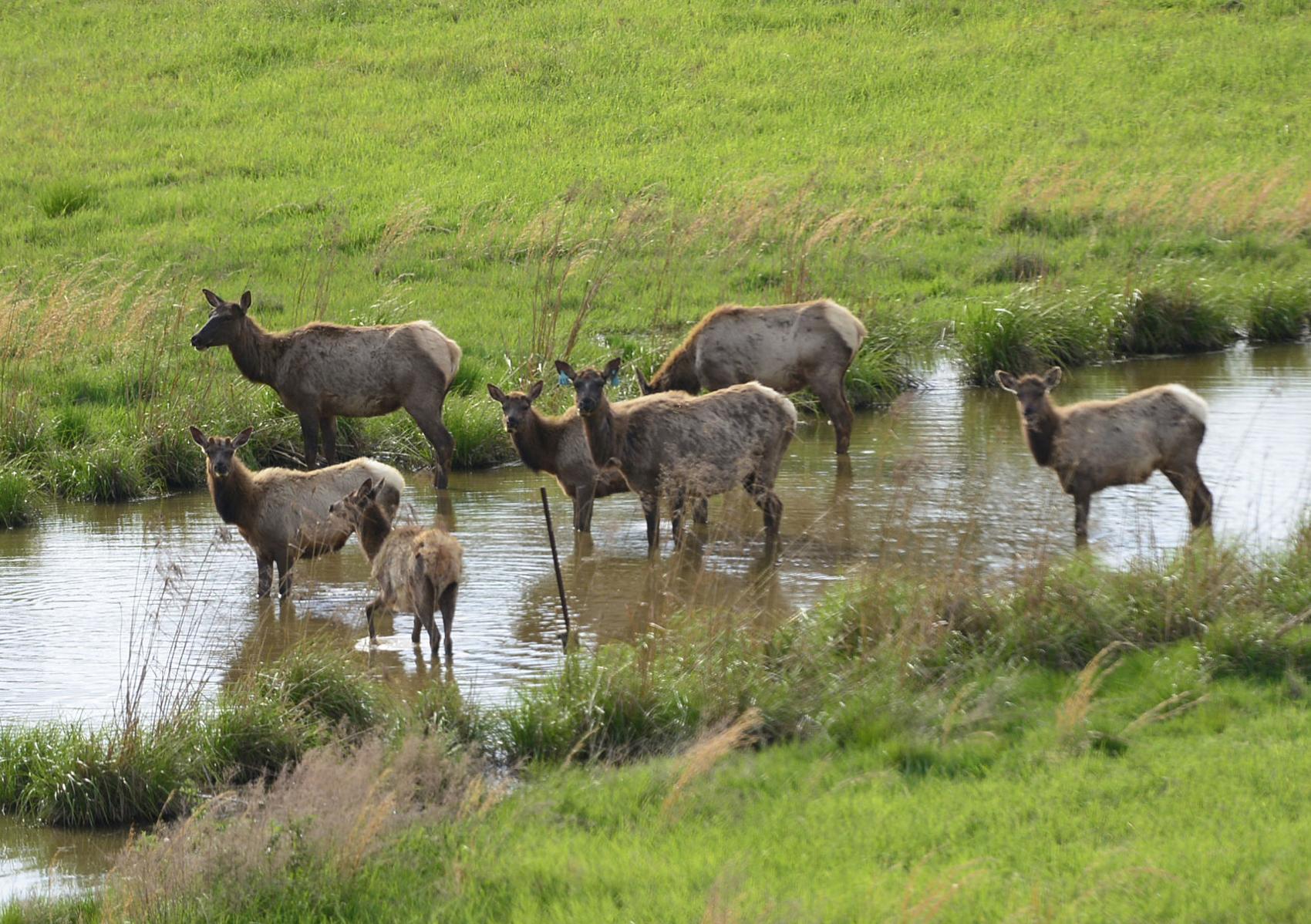Where the Wild Things Are: Elk a Tourism Draw for Southwest Virginia

By Samantha Perry
May 5, 2019 - High on a Southwest Virginia mountaintop a herd of majestic elk, once native to the area, meander through a pond before pausing in a field of bright green grass.
The mother cows, many accompanied by yearlings, eye the pickup truck on a nearby gravel-and-dirt drive, then just as quickly dismiss it.

A herd of elk gathers near a stream at the elk sanctuary in Buchanan County.
Photo by Jessica Nuzzo
This is their habitat — their home. But visitors are welcome.
As a result of an elk relocation project on land once mined for its high-grade coal, the animals are spawning a tourism boon. Individuals and groups flock to the mountains to see herds of the elk in a pristine setting.
A few miles down from the herd, a solitary bull is seen drinking from a pond. His weight is estimated as “around 900 pounds” by tour guide John Taylor, a member of the Southwest Virginia Sportsman group and the Southwest Virginia Chapter of the Rocky Mountain Elk Foundation.
On this May day the bull’s antlers have been shed, but his nubs are about five inches high.
The elk beginning shedding their antlers in April, and “by May most of the big ones have shed,” Taylor said.
“Shed hunting has become its own season,” he said, explaining how visitors will scour the land looking for the enormous antlers.
Taylor smiled when noting he was recently fortunate to find “the left side of a seven by seven.”
The large size of the elk and their impressive nature bring awe to the thousands of tourists now visiting the mountains nestling the small town of Grundy.
Taylor said that mature elk bulls can weigh about 1,100 to 1,200 pounds when fully mature.
Their stately size yet gentle presence bring a sense of revere and respect to those who travel the country roads to see them.
The vision for the elk project in Buchanan County, Va., began nearly 10 years ago when the local chapter of the elk foundation was initiated.
“We opened our chapter in 2010 and our first elk were transplanted in 2012,” Taylor said. “We had subsequent releases in 2013 and 2014.”
The first elk — 74 head — were brought from Kentucky, with protocol dictating they be initially placed in a holding/quarantine facility. “Right now I think we have 240 to 245 head,” Taylor said.
The elk habitat is on several hundred acres of reclaimed land that was once a mountaintop mine site.
Taylor said it is perfect for elk habitat, which consists of public viewing areas and a sanctuary that is generally closed to the public.
The herd is now in three distinctive groups — one that favors the Southern Gap, a second that has started making its way to the Breaks Interstate Park and a third that prefers the War Fork area, a region that is within the sanctuary.
Although a new sight to current residents and visitors, elk were once native to the area. Taylor notes that the eastern elk were hunted to extinction.
When planning its elk restoration project, those in the Commonwealth looked to their neighbor.
“Kentucky has had amazing success with its elk restoration program,” Taylor said. “We had elk crossing over (into Virginia).”
However, appropriate habitat needed to be found.
“Buchanan County has no flat land,” Taylor explained. “The reclaimed mining and gas land makes good foraging for elk. Reclamation gives us flat land.
“The whole area used to be a coal mine,” he said. “When they put it back, it gave us something to work with. It just fits.”
The purpose of the elk relocation project is for tourism and, ultimately, hunting.
The land for the elk restoration project is intertwined with the Spearhead trail, allowing all-terrain vehicle riders to interact with nature while on recreational rides.
“The riders don’t seem to bother the elk that much,” Taylor said, noting he has seen groups of 25 or so riders parked alongside the road watching the herds.
“A lot of times we see ATV riders watching the critters,” he said.
Cabin and primitive camping sites are also available along the trails and within the elk viewing areas.
“We have a great deer population, and now the elk are beginning to thrive. It’s a great tourist attraction,” Taylor said. “Buchanan County is the elk capital of Virginia right now.”
Attractive wooden viewing stations allow guests a place to view the elk. Taylor notes the hand-hewn stone around the stations is from the old sheriff’s office in town.
Food plots and water sources are strategically located in areas below the viewing stations.
“The food is not just for the elk, it also helps other wildlife like deer,” Taylor said. “The wild turkey population is doing really well, too.”
Taylor said “right after daylight and just before dark” are the best times to see the elk during the summer months. “In the winter they are out and about more during the day.”
For many retirees in the area, elk watching has become part of the day-to-day routine. Taylor said they will go to a fast-food restaurant for breakfast, then go to a station to watch they elk. Some can even distinguish specific elk, which they have named.
“For some of the retired folks, it’s part of their routine,” he said.
The elk stations are not just for solitary viewing. Taylor said businesses, families and other groups will often have picnics or cookouts at the stations.
One mountain over from the viewing stations is the elk sanctuary, an area not open to the general public except during special bus tours facilitated by the Breaks park. “Those on the bus tour can be guided into the sanctuary,” Taylor said.
“The elk can come over (near the viewing stations) to get food, but then can retreat back to the sanctuary,” Taylor explained.
A variety of plants and grasses are seeded in food plots on the relocation land, providing a habitat conducive to the melding of flora and fauna.
“This helps them sustain and survive in wintertime and not get into trouble,” Taylor said. “Not as many get hit by cars.”
Taylor said the food plots help other species as well, including deer, bear, squirrels and wild turkeys.
“We’ve seen a dramatic increase in migratory birds,” he noted.
For the most part, Taylor said they have had good luck with the health of the elk population.
“We’ve lost a few to bulls fighting, and lost a few to poaching,” he said.
He also detailed a nasty small snail parasite called “brainworm” that eats the grass and can infect the animals. “The whitetail have an immunity to it, but not the elk. We’ll lose a few to it.”
Accidents involving vehicles versus elk have not been a big problem.
“For the most part, we’ve had very good luck with keeping them out of the road,” Taylor said. “Elk don’t want to be around people.”
Although a few elk will occasionally cross a section of road or wander into the yards of nearby homeowners, Taylor said they generally stay within their habitat.
Upcoming plans for the elk project include a new viewing station in the sanctuary being built by the Boy Scouts and, Taylor hopes, the resumption of a live streaming elk cam.
“It ran about three months (August through October) last year,” he said. “We had hits from over 40 different countries.”
Hunting via a lottery system may also be offered in a few years.
The elk have become a huge tourism draw for the southwestern Virginia county, Taylor said.
Asked about the number of visitors, he responded, “I would say in the tens of thousands each year come to see the elk.”

